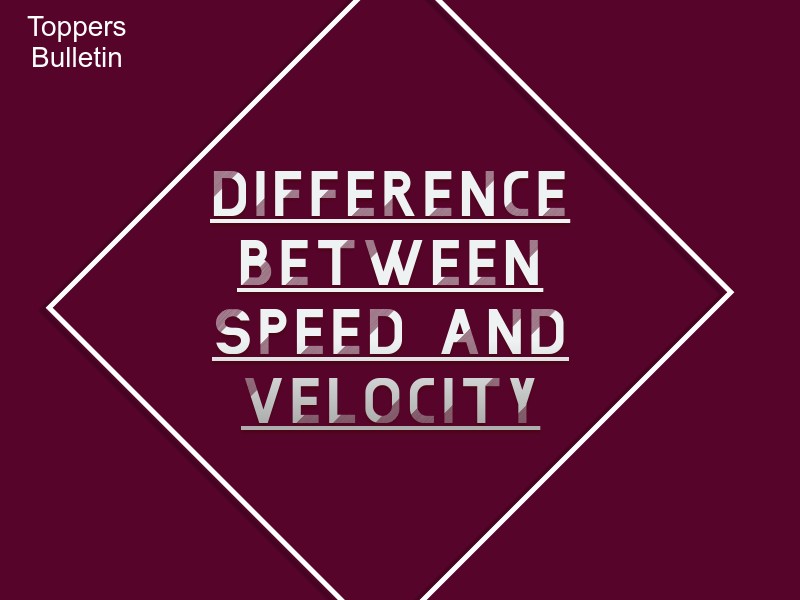Speed and Velocity: Understanding the Difference Between Speed and Velocity
Speed and velocity are fundamental concepts in physics that describe how objects move. Although they both involve the rate of motion, they represent different aspects of an object’s movement. In this article, we will delve into the differences between speed and velocity. Understand how speed measures the rate of movement, while velocity considers both speed and direction. Learn about their calculations, graphical representations, and real-world applications in transportation, navigation, and space exploration.
What is Speed: The Measure of Rate
Speed is a scalar quantity that measures how fast an object is moving, irrespective of its direction. It is the magnitude of the object’s velocity and is always positive or zero. Speed is typically measured in units like meters per second (m/s) or kilometers per hour (km/h).
What is Velocity: The Measure of Rate and Direction
Velocity, on the other hand, is a vector quantity that not only measures how fast an object is moving but also indicates its direction. Velocity includes both magnitude and direction and can be either positive or negative, depending on the direction of motion. Like speed, velocity is measured in units like meters per second (m/s) or kilometers per hour (km/h).
Calculating Speed and Velocity
The formulas to calculate speed and velocity are relatively straightforward. Speed is determined by dividing the distance traveled by the time taken, as follows:
Speed (S) = Distance (D) / Time (T)
Velocity, being a vector quantity, considers both distance and direction. To calculate velocity, you need to divide the displacement (change in position) by the time taken:
Velocity (V) = Displacement (Δx) / Time (T)
Graphical Representation
Speed and velocity can be represented graphically using distance-time and displacement-time graphs. On a distance-time graph, the speed of an object is represented by the slope of the line. For velocity, the direction is indicated by the slope’s sign.
Constant Speed vs. Constant Velocity
An object moving with constant speed covers equal distances in equal time intervals. In contrast, an object moving with constant velocity covers equal displacements in equal time intervals, irrespective of changes in speed.
Real-World Applications
The difference between speed and velocity has numerous real-world applications. In transportation, knowing the speed of vehicles helps in setting speed limits and designing efficient transportation systems. Velocity measurements are vital in navigation, satellite positioning, and space exploration.
Conclusion
Speed and velocity are essential concepts in understanding the motion of objects. While speed measures how fast an object moves without considering direction, velocity takes both speed and direction into account. Recognizing these differences enhances our comprehension of various physical phenomena and practical applications in fields ranging from sports to space exploration.
Frequently Asked Questions (FAQs) – Speed and Velocity
1. What is speed?
Speed is a scalar quantity that measures how fast an object is moving, regardless of its direction. It is the magnitude of an object’s velocity and is typically measured in units like meters per second (m/s) or kilometers per hour (km/h).
2. What is velocity?
Velocity is a vector quantity that measures how fast an object is moving and indicates its direction. It includes both magnitude and direction and is measured in units like meters per second (m/s) or kilometers per hour (km/h).
3. How are speed and velocity different?
The main difference between speed and velocity lies in their consideration of direction. Speed only measures how fast an object moves, while velocity takes both speed and direction into account.
4. How do you calculate speed and velocity?
To calculate speed, divide the distance traveled by the time taken. For velocity, divide the displacement (change in position) by the time taken.
5. Can speed be negative?
No, speed is always positive or zero as it represents the magnitude of motion, irrespective of direction.
6. Can velocity be negative?
Yes, velocity can be negative when the object is moving in the opposite direction of the chosen reference point. Positive velocity indicates motion in the chosen direction.
7. What is the difference between constant speed and constant velocity?
An object moving with constant speed covers equal distances in equal time intervals. On the other hand, an object moving with constant velocity covers equal displacements in equal time intervals, regardless of changes in speed.

